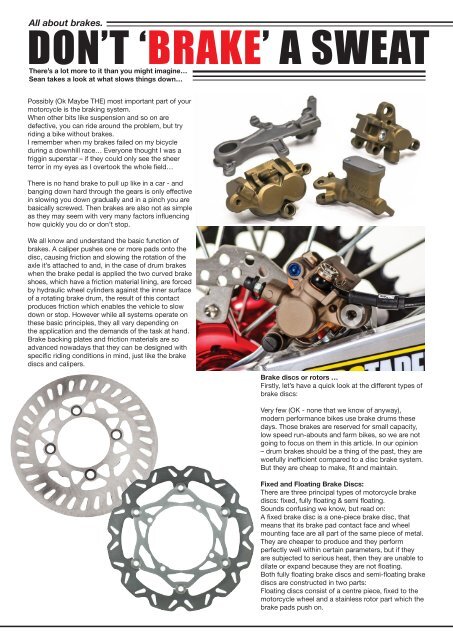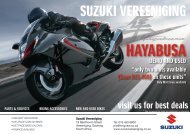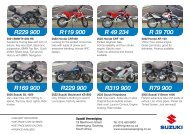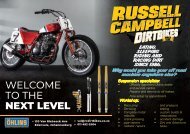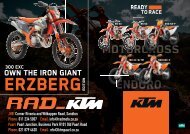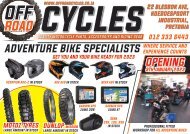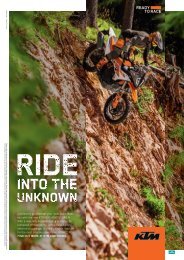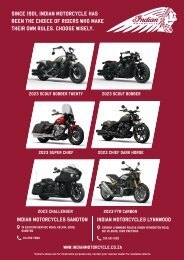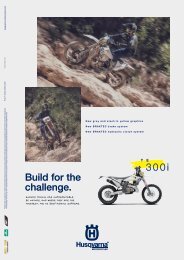Create successful ePaper yourself
Turn your PDF publications into a flip-book with our unique Google optimized e-Paper software.
All about brakes.<br />
DON’T ‘BRAKE’ A SWEAT<br />
There’s a lot more to it than you might imagine…<br />
Sean takes a look at what slows things down…<br />
Possibly (Ok Maybe THE) most important part of your<br />
motorcycle is the braking system.<br />
When other bits like suspension <strong>and</strong> so on are<br />
defective, you can ride around the problem, but try<br />
riding a bike without brakes.<br />
I remember when my brakes failed on my bicycle<br />
during a downhill race… Everyone thought I was a<br />
friggin superstar – if they could only see the sheer<br />
terror in my eyes as I overtook the whole field…<br />
There is no h<strong>and</strong> brake to pull up like in a car - <strong>and</strong><br />
banging down hard through the gears is only effective<br />
in slowing you down gradually <strong>and</strong> in a pinch you are<br />
basically screwed. Then brakes are also not as simple<br />
as they may seem with very many factors influencing<br />
how quickly you do or don’t stop.<br />
We all know <strong>and</strong> underst<strong>and</strong> the basic function of<br />
brakes. A caliper pushes one or more pads onto the<br />
disc, causing friction <strong>and</strong> slowing the rotation of the<br />
axle it’s attached to <strong>and</strong>, in the case of drum brakes<br />
when the brake pedal is applied the two curved brake<br />
shoes, which have a friction material lining, are forced<br />
by hydraulic wheel cylinders against the inner surface<br />
of a rotating brake drum, the result of this contact<br />
produces friction which enables the vehicle to slow<br />
down or stop. However while all systems operate on<br />
these basic principles, they all vary depending on<br />
the application <strong>and</strong> the dem<strong>and</strong>s of the task at h<strong>and</strong>.<br />
Brake backing plates <strong>and</strong> friction materials are so<br />
advanced nowadays that they can be designed with<br />
specific riding conditions in mind, just like the brake<br />
discs <strong>and</strong> calipers.<br />
Brake discs or rotors …<br />
Firstly, let’s have a quick look at the different types of<br />
brake discs:<br />
Very few (OK - none that we know of anyway),<br />
modern performance bikes use brake drums these<br />
days. Those brakes are reserved for small capacity,<br />
low speed run-abouts <strong>and</strong> farm bikes, so we are not<br />
going to focus on them in this article. In our opinion<br />
– drum brakes should be a thing of the past, they are<br />
woefully inefficient compared to a disc brake system.<br />
But they are cheap to make, fit <strong>and</strong> maintain.<br />
Fixed <strong>and</strong> Floating Brake Discs:<br />
There are three principal types of motorcycle brake<br />
discs: fixed, fully floating & semi floating.<br />
Sounds confusing we know, but read on:<br />
A fixed brake disc is a one-piece brake disc, that<br />
means that its brake pad contact face <strong>and</strong> wheel<br />
mounting face are all part of the same piece of metal.<br />
They are cheaper to produce <strong>and</strong> they perform<br />
perfectly well within certain parameters, but if they<br />
are subjected to serious heat, then they are unable to<br />
dilate or exp<strong>and</strong> because they are not floating.<br />
Both fully floating brake discs <strong>and</strong> semi-floating brake<br />
discs are constructed in two parts:<br />
Floating discs consist of a centre piece, fixed to the<br />
motorcycle wheel <strong>and</strong> a stainless rotor part which the<br />
brake pads push on.


